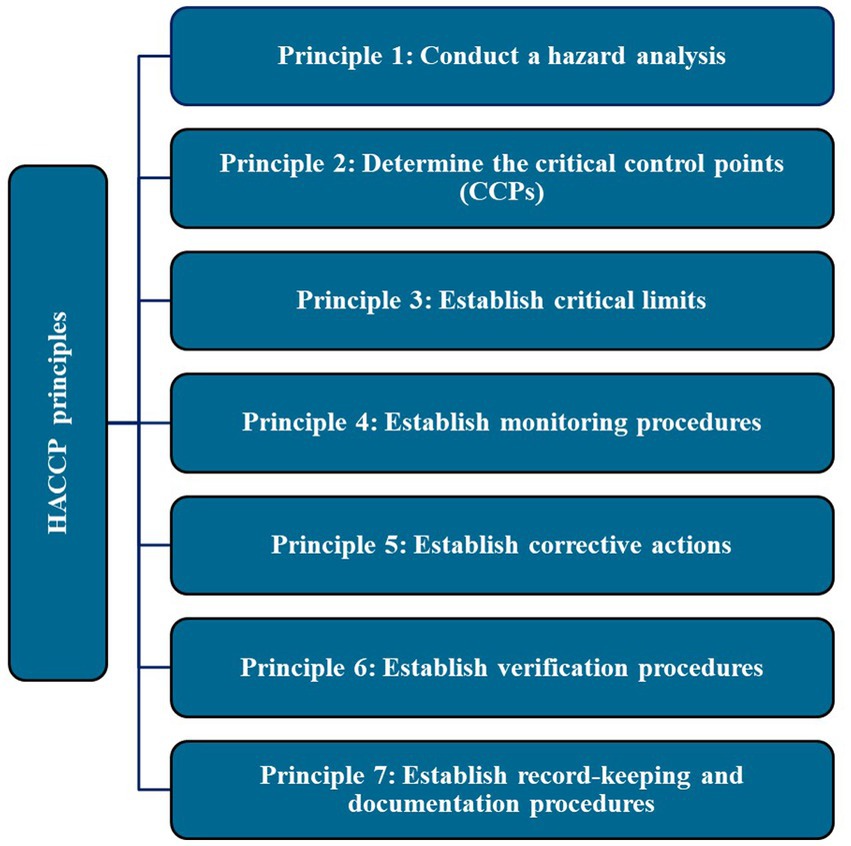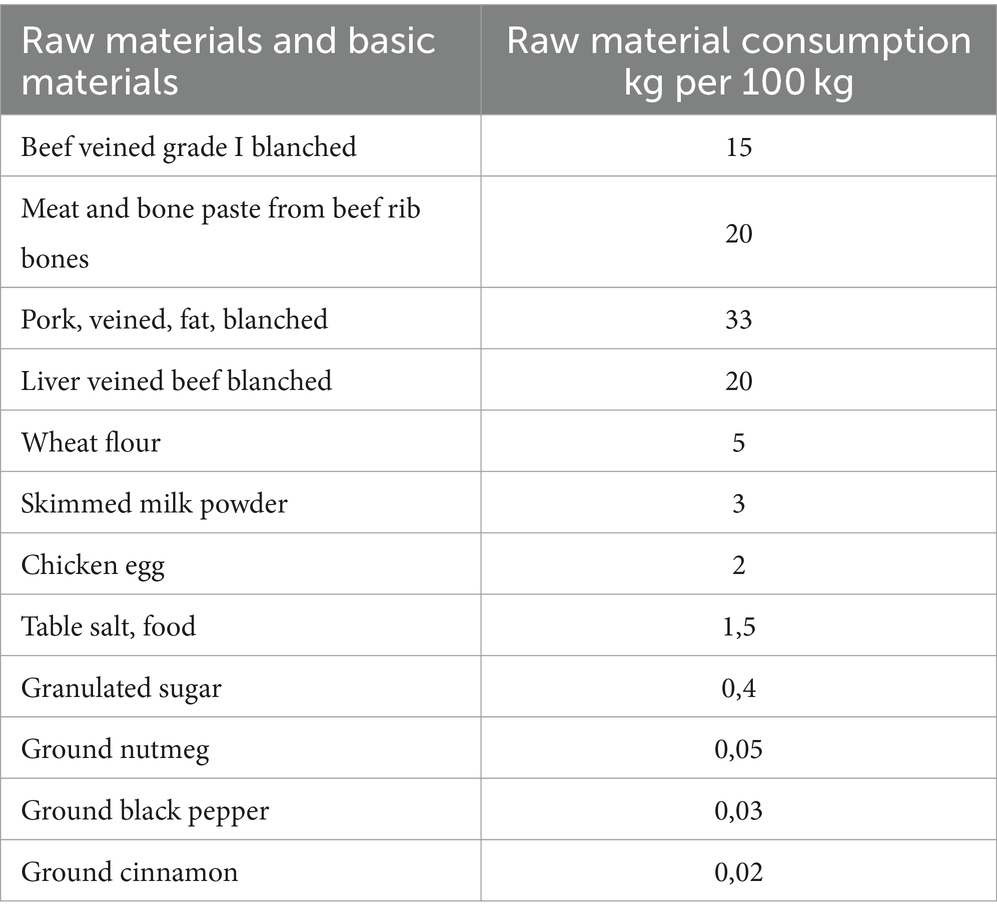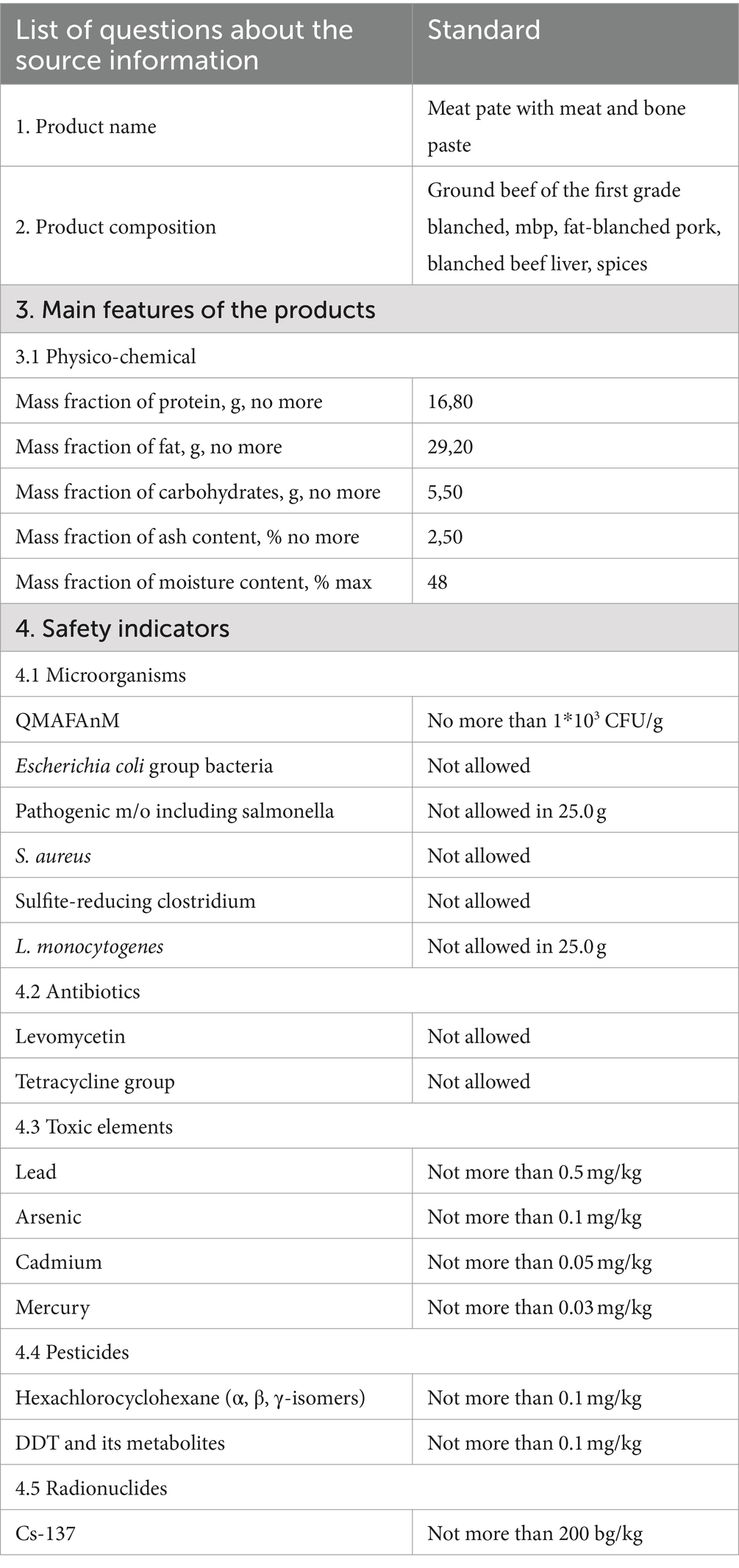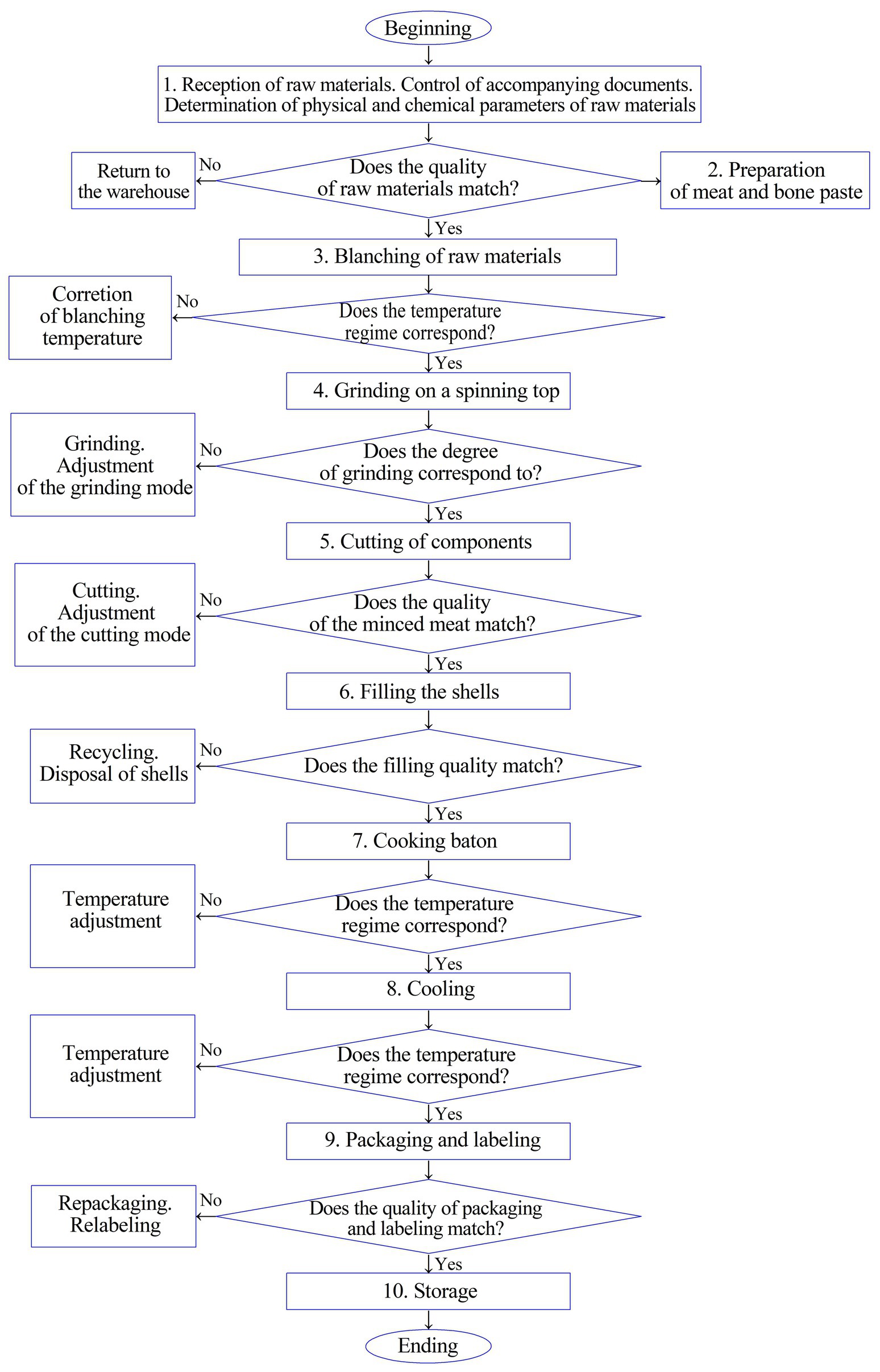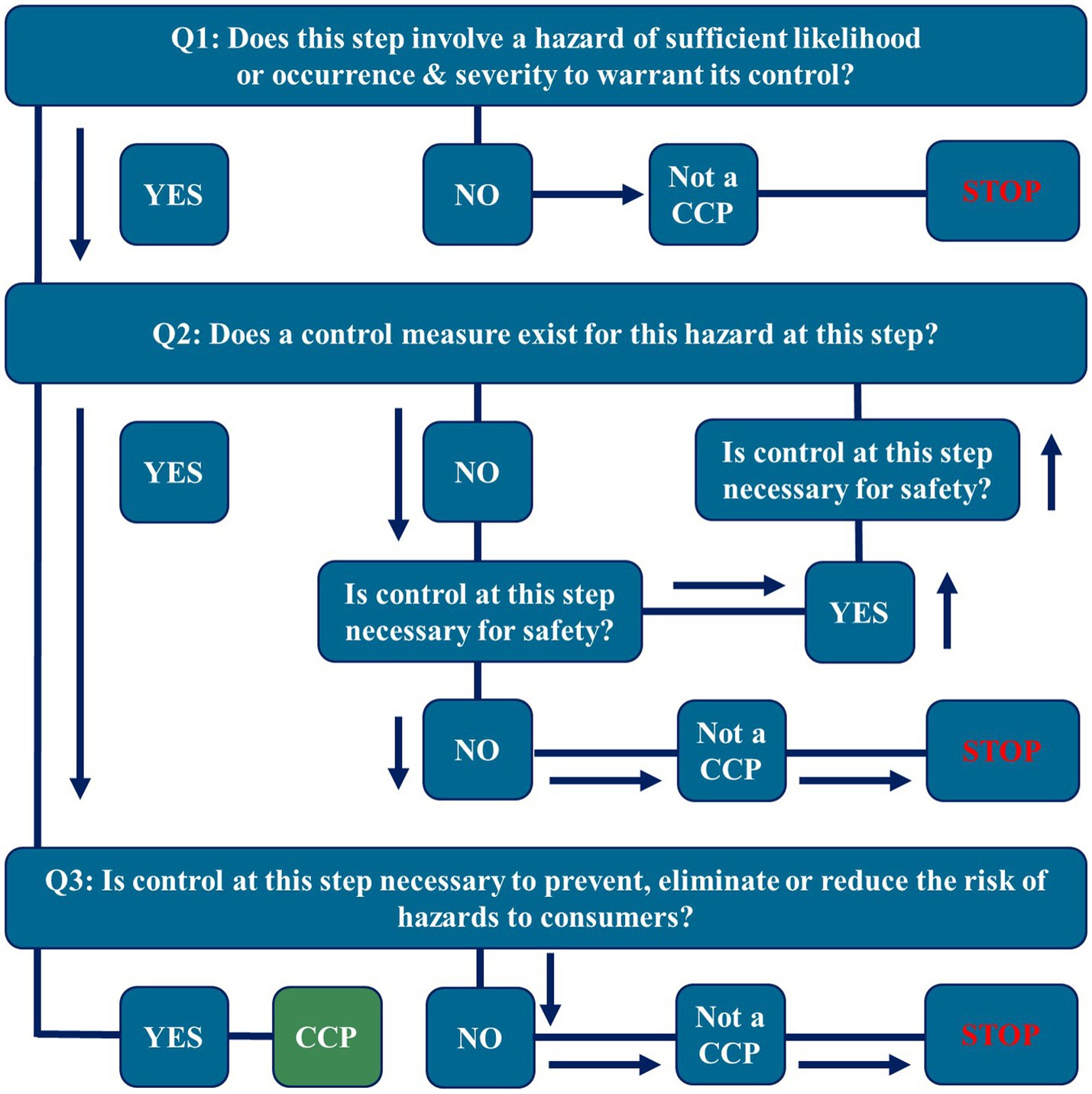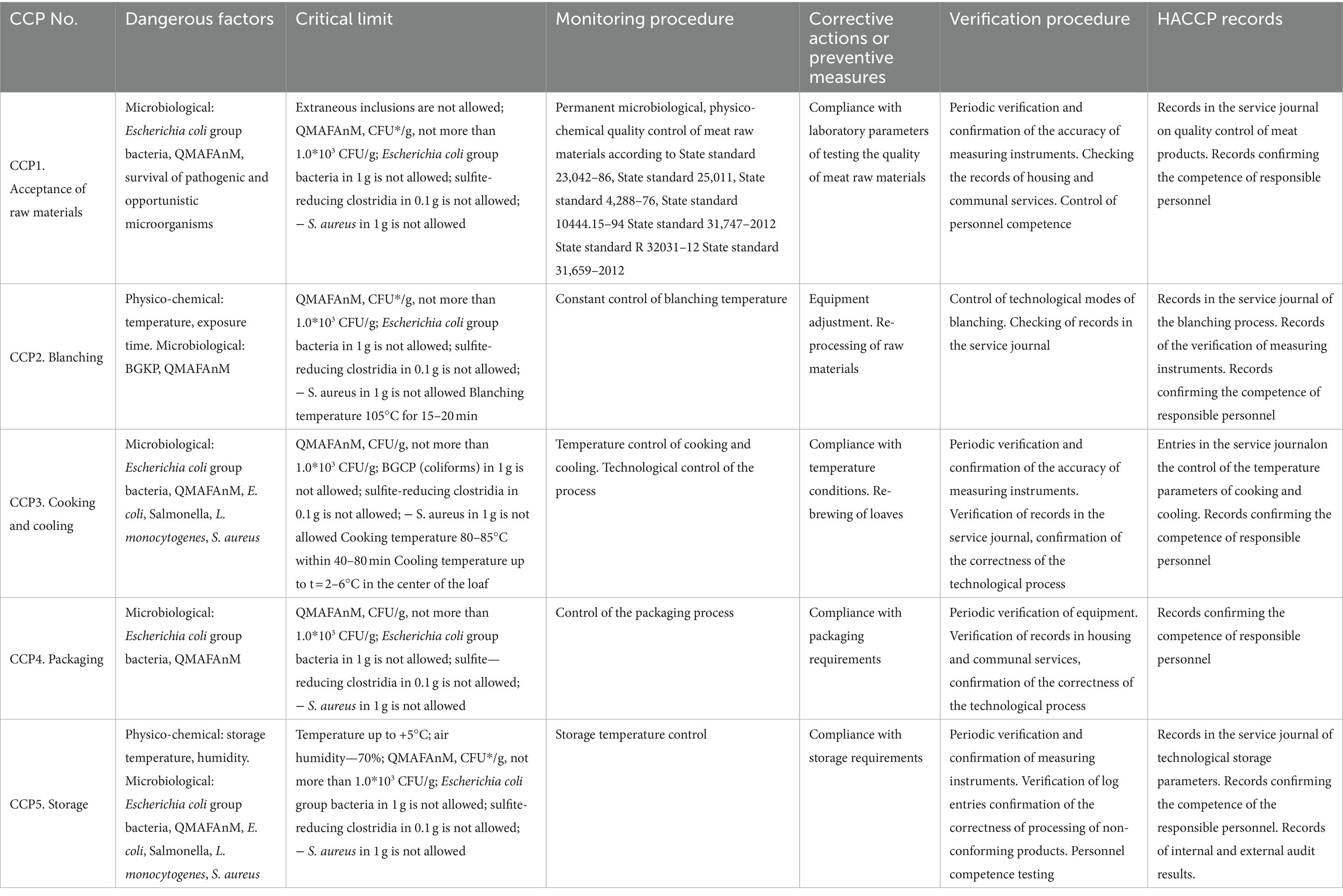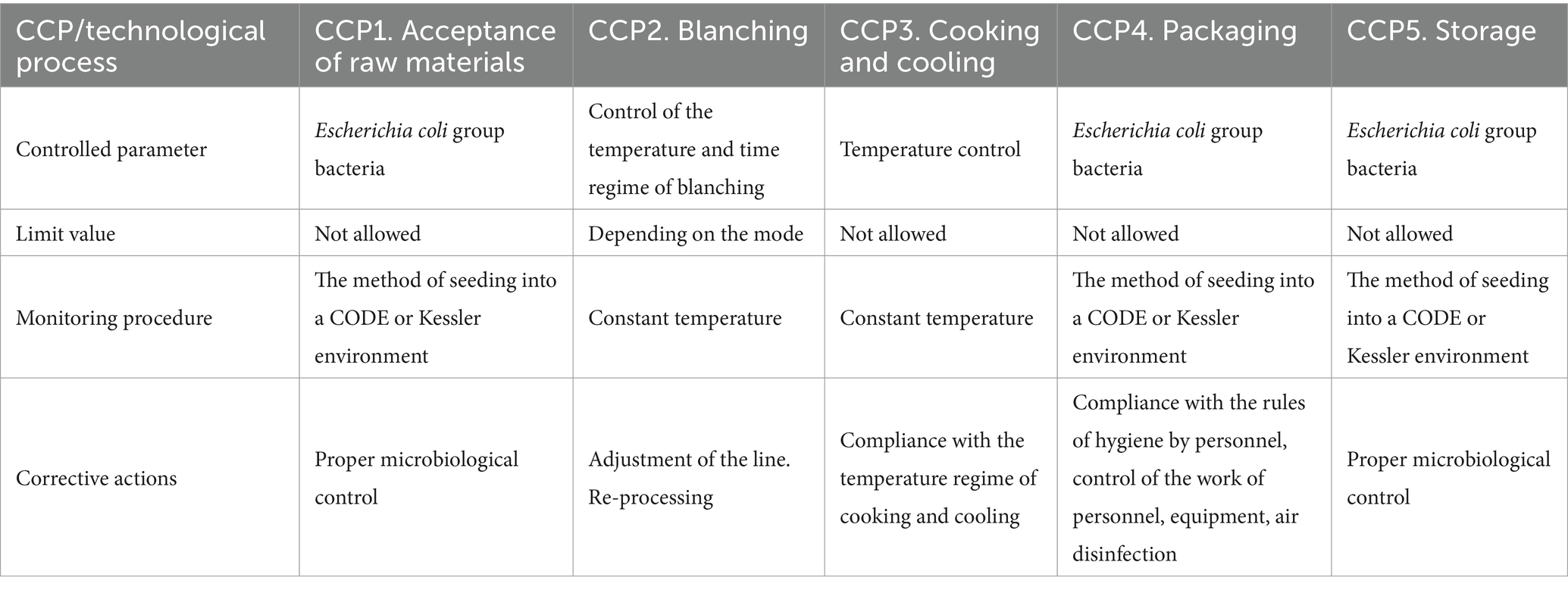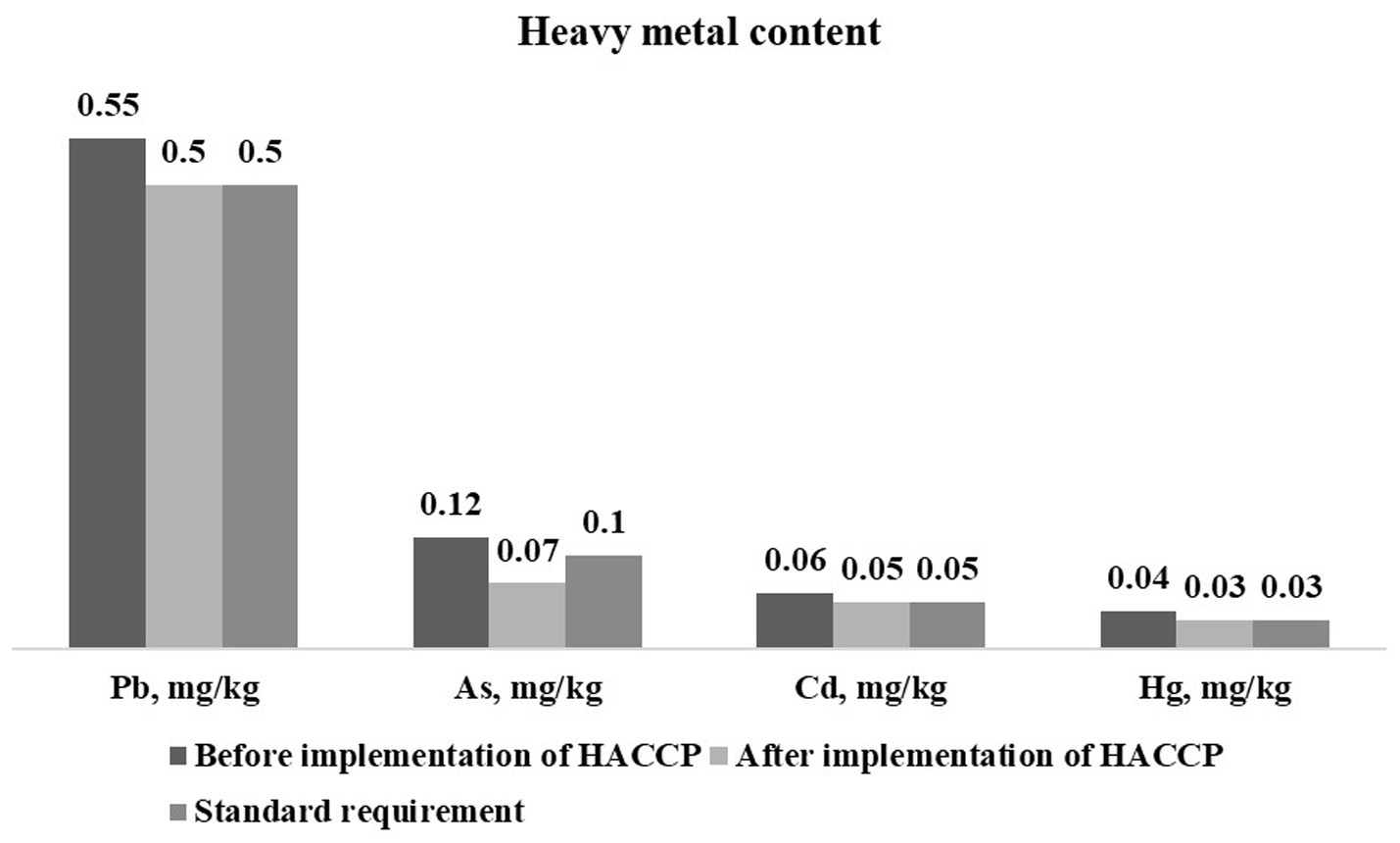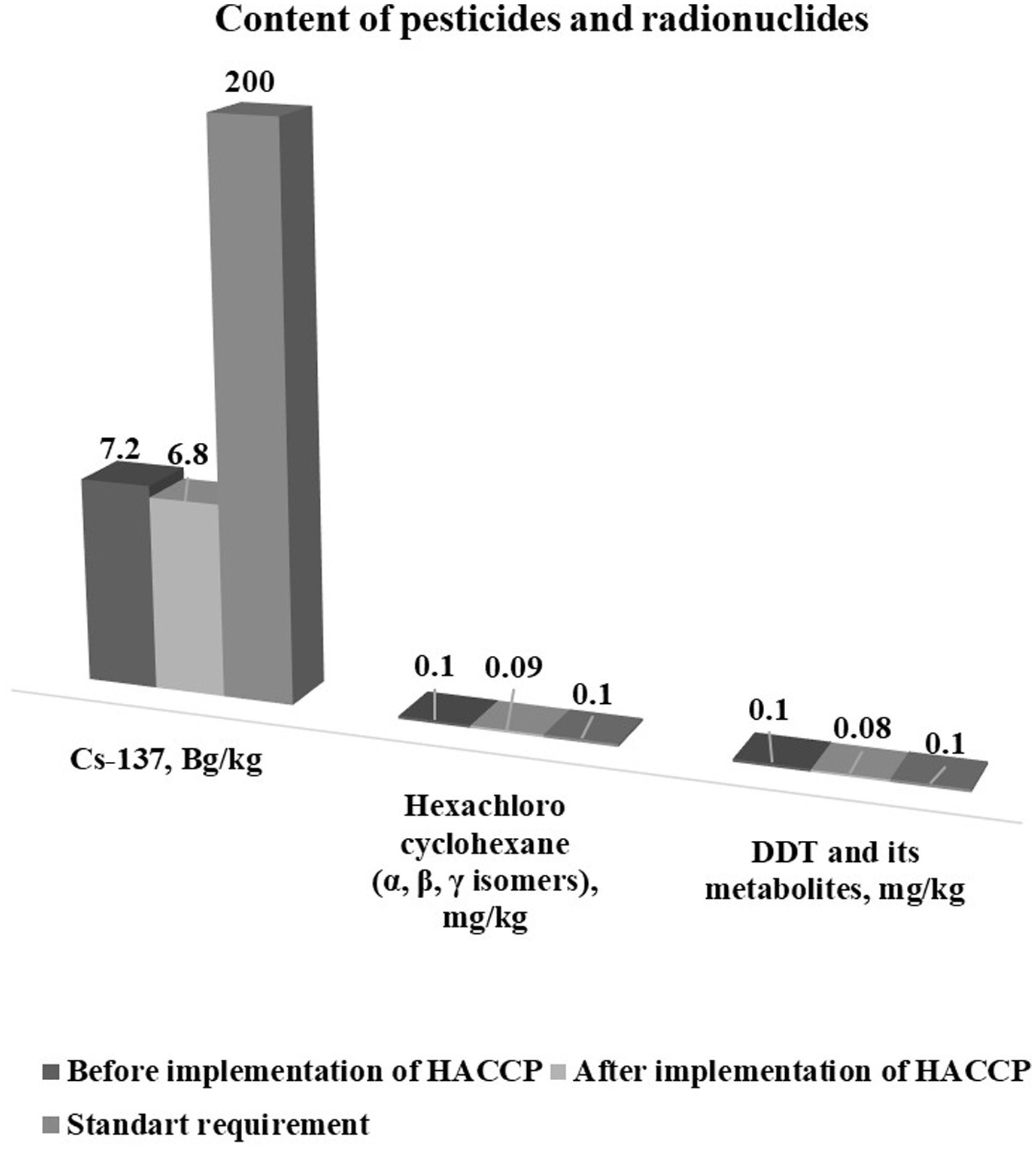- 1Department of Food Production Technology and Biotechnology, Shakarim University of Semey, Semey, Kazakhstan
- 2Department of Chemical Technology and Ecology, Shakarim University of Semey, Semey, Kazakhstan
- 3Department of Technological Equipment and Mechanical Engineering, Shakarim University of Semey, Semey, Kazakhstan
- 4Department of Technology of Food and Processing Products, S. Seifullin Kazakh Agrotechnical University, Astana, Kazakhstan
This study developed and implemented a specific HACCP plan for the meat pate “Phirmennyi” at the small meat processing enterprise “Alteev” in Semey, Kazakhstan. The research, conducted in collaboration with the Department of Food Production Technology and Biotechnology at Shakarim University, was carried out in an area affected by the ecological consequences of the former Semipalatinsk Nuclear Test Site. The study aimed to identify critical control points (CCPs) and assess potential risks following the Technical Regulations of the Customs Union. Additionally, it evaluated the effectiveness of the HACCP plan in reducing contaminants, such as heavy metals, radionuclides, and pesticides, while considering the region’s environmental impact on food safety and quality. Standard procedures were followed for hazard analysis, CCP identification, setting critical limits, monitoring, corrective actions, verification, and record-keeping. Heavy metals were measured using inductively coupled plasma mass spectrometry, while Cs-137 radionuclides were analyzed with scintillation and semiconductor gamma spectrometers. Statistical analysis was conducted in Microsoft Excel to compute mean values, standard deviations, and correlations, with significance defined at p ≤ 0.05. Five CCPs were identified during the production of an experimental batch of meat pâté, including raw material acceptance, blanching, cooking, cooling, and packaging/storage. Implementing this plan resulted in a reduction in contaminants, including a decrease in lead from 0.55 to 0.51 mg/kg, arsenic from 0.12 to 0.07 mg/kg, and Cs-137 from 7.2 to 6.8 Bq/kg. By addressing both the contaminants and the specific environmental context of the region, this research demonstrates the critical role of a well-structured food safety plan. The HACCP system not only improved food quality but also ensured compliance with safety standards, providing reassurance to consumers. This case study advocates for broader adoption of food safety management in regions with similar ecological challenges, promoting a more sustainable and secure food supply chain.
1 Introduction
Ensuring food safety and quality is a critical concern in the food industry, particularly in regions facing ecological challenges. The Hazard Analysis and Critical Control Points (HACCP) system has emerged as a robust framework for identifying, evaluating, and controlling food safety hazards throughout the production process (Chavan et al., 2024). While this system has proven effective in various settings, its implementation in ecologically compromised areas presents unique challenges that require specific attention.
Regions with environmental hazards often face significant obstacles in establishing comprehensive food safety systems. The presence of environmental contaminants, including heavy metals, radionuclides, and pesticide residues, complicates the monitoring and control of food safety risks (Polivkina et al., 2021; Moldagazyyeva et al., 2022). To overcome these challenges, tailored strategies that incorporate environmental considerations into food safety protocols are essential, ensuring the protection of public health and the enhancement of food quality under adverse conditions.
The city of Semey, Kazakhstan, exemplifies such challenges. The legacy of the former Semipalatinsk nuclear test site has resulted in widespread contamination of soil, water, and air, adversely impacting public health in the region (Krivitskiy et al., 2022; Kunduzbayeva et al., 2022; Duyssembayev et al., 2023; Krasnopyorova et al., 2023; Turchenko et al., 2023). This contamination has been linked to increased rates of cancer (Gusev et al., 1998), birth defects (Abylgazinova et al., 2016), and various health problems among the local population (Iwata et al., 2004; Teleuov, 2007; Semenova et al., 2021).
In this context, integrating the Food Safety Management System into Semey’s food processing industry is crucial. The small-scale meat products enterprise (SMPE) “Alteev” has taken the initiative to implement this system in its production process to ensure the safety and quality of its meat products. This study aims to evaluate the effectiveness of the HACCP approach in mitigating food safety hazards in this ecologically challenged area.
The specific objectives of this research include investigating the presence of heavy metals and radionuclides, such as Cs-137, as well as antibiotic and pesticide residues in the final products, particularly those containing meat and bone paste derived from beef rib bones (MBP). Furthermore, the study will assess changes in contamination levels before and after the implementation of the HACCP framework. By conducting this research, we aim to demonstrate the potential benefits of the system in improving food safety and quality under challenging environmental conditions.
This study contributes to the existing literature by providing empirical evidence on the effectiveness of the HACCP framework in an ecologically unfavorable area, highlighting unique challenges and potential solutions for implementing food safety management systems in such contexts. The findings are expected to inform policymakers, food industry stakeholders, and public health authorities about the importance of integrating environmental considerations into food safety protocols to protect consumer health and enhance food quality.
2 Literature review
The HACCP system plays a pivotal role in safeguarding food safety and enhancing quality across various food processing industries. Its integration can significantly improve overall food quality by fostering consistency, minimizing variability, and ensuring adherence to established standards. This is essential for building consumer confidence and maintaining market competitiveness, particularly in regions where environmental or resource limitations present challenges to food safety.
Focusing on Semey, Kazakhstan—a region impacted by nuclear contamination—this study examines contamination levels in meat products before and after the integration of this safety management system, aiming to demonstrate its effectiveness in improving food safety and quality amid significant environmental challenges.
2.1 HACCP system and food safety
Previous studies have demonstrated the effectiveness of the HACCP framework in reducing foodborne illnesses and improving overall food quality. For instance, Radu et al. (2023) found that implementing this system in a food processing facility led to a significant decrease in foodborne illness outbreaks. Similarly, Wallace and Mortimore (2016) reported that the methodology helped identify and control potential hazards in a seafood processing plant, resulting in enhanced product safety and quality.
However, applying this framework can be challenging in ecologically unfavorable areas, such as those with limited resources or inadequate infrastructure. Bolat (2002) identified obstacles including a lack of trained personnel, insufficient monitoring and control measures, and limited resources for maintaining records and documentation in developing countries. Despite these challenges, there is increasing recognition of the potential advantages of this approach in such contexts. For example, Torres (2000) highlighted how the system could improve food safety and quality in small-scale fisheries in developing regions, leading to better market access and competitiveness. Njoagwuani et al. (2023) suggested that implementing this framework could help address food safety challenges faced by vulnerable populations, such as children and the elderly, in resource-limited settings.
In addition to these examples, other regions across the world have successfully applied the HACCP system in areas facing similar ecological challenges. For instance, in post-Chernobyl Ukraine, the implementation of food safety protocols, including HACCP, proved essential in addressing the contamination of agricultural products with radionuclides. Studies have highlighted the importance of food safety protocols, including HACCP, in managing contamination risks. Research has shown that these protocols are crucial for ensuring safety in agricultural products affected by radionuclides. A technical report by Greenpeace discusses the contamination of agricultural products in the Chernobyl region and the methods used to address it, including HACCP implementation (Labunska et al., 2016).
Similarly, in the aftermath of the Fukushima nuclear disaster in Japan, Bai et al. (2023) reported that local food industries utilized HACCP to systematically monitor and control contamination risks in seafood and agricultural products, achieving compliance with international safety standards. In both cases, the adaptability of the HACCP system to mitigate risks in compromised environments demonstrates its robustness under extreme conditions.
In regions like sub-Saharan Africa, where water scarcity and poor sanitation pose significant risks to food safety, the HACCP system has also proven effective. Studies have demonstrated HACCP’s effectiveness in regions with water scarcity and poor sanitation, particularly in improving livestock product safety (Oguntoyinbo, 2012). These global examples underscore the adaptability of the HACCP framework, even in challenging environmental conditions.
2.2 Ecological challenges in Semey, Kazakhstan
The city of Semey, Kazakhstan, serves as a stark reminder of the enduring challenges faced by regions burdened with significant ecological issues. Established in 1948, the former Semipalatinsk nuclear test site conducted an extensive series of nuclear tests totaling at least 468 between 1949 and 1989 (Adamdar, 2019). The lasting legacy of these tests has profoundly impacted the region’s environment and public health, resulting in widespread contamination of soil, water, and air (Bauer et al., 2013; Apsalikova et al., 2024). This contamination has been linked to elevated rates of cancer, birth defects, and other health issues among the local population (Grosche et al., 2015).
In such an ecologically compromised area, the implementation of robust food safety measures becomes not only essential but also challenging. Despite ongoing efforts to clean up and rehabilitate the site, Semey continues to contend with persistent soil contamination, water pollution, and health risks associated with radioactive materials (Stepanenko et al., 2006; Timonova et al., 2020; Krivitskiy et al., 2022). This underscores the critical and ongoing need for rigorous monitoring, comprehensive assessment, and effective mitigation strategies to address both environmental degradation and public health concerns (Grosche et al., 2002).
The HACCP system in Semey’s food processing industry is particularly crucial amidst these challenges. By implementing HACCP protocols, local enterprises can systematically identify, evaluate, and control food safety hazards, thereby enhancing consumer protection and ensuring compliance with rigorous safety standards (Sperber et al., 2018). This approach not only mitigates risks associated with environmental contamination but also fosters resilience against ecological adversities, safeguarding both public health and the integrity of the food supply chain (Aruoma, 2006).
As Semey continues to navigate the complex aftermath of its nuclear history, the adoption of proactive and science-based food safety practices remains pivotal. Such measures are vital not only for restoring confidence in local food products but also for promoting sustainable development and ensuring the well-being of the community in the face of ongoing environmental challenges.
2.3 HACCP implementation in ecologically unfavorable areas
SMPE “Alteev” in Semey has undertaken the integration of the HACCP framework into its production process to ensure the safety and quality of its meat offerings. This study aims to investigate the presence of heavy metals, radionuclides, antibiotics, and pesticide residues in final products containing MBP. Additionally, it will assess changes in contamination levels before and after the system’s implementation.
Through this research, the potential benefits of adopting this framework in improving food safety and quality under challenging environmental conditions will be demonstrated. The study contributes to existing literature by providing empirical evidence on its effectiveness in ecologically unfavorable areas, highlighting unique challenges and potential solutions for food safety management systems in such contexts.
The findings are expected to inform policymakers, industry stakeholders, and public health authorities on the necessity of incorporating environmental considerations into food safety protocols to protect consumer health and enhance product quality. By addressing these specific challenges through a comprehensive safety management system, the study aims to illustrate the potential for improving food safety and quality, even in regions facing significant environmental hurdles. This literature review emphasizes the critical importance of such a system and sets the stage for evaluating its effectiveness in the Semey context, while drawing on global examples of HACCP implementation in similarly challenged regions, such as Chernobyl, Fukushima, sub-Saharan Africa, and small Pacific islands.
3 Materials and methods
This study was carried out at the SMPE—“Alteev” in Semey city, East Kazakhstan. The company produces meat products such as sausages, patties, and cutlets.
3.1 Sample collection
The following ingredients were sourced from nearby farms to ensure high freshness and minimal structural alterations in the meat:
• Beef (Grade I)
• Meat and bone paste from beef rib bones (MBP)
• Blanched pork fat
• Blanched beef liver
• Wheat flour
• Skimmed milk powder
• Chicken eggs
• Spices
3.2 Study design
The study aimed to investigate the presence of heavy metals, radionuclides, antibiotics, and pesticide residues in final products containing MBP. Data collection occurred during two periods: November 2022–April 2023 (prior to HACCP implementation) and November 2023–April 2024 (post-implementation). All analyses were conducted at the certified testing center of JSC “National Center for Expertise and Certification” in Semey, Kazakhstan, following the approved standards of the Republic of Kazakhstan.
3.3 Methodology for HACCP development
The HACCP framework is a preventive approach to food safety that targets physical, chemical, and biological hazards throughout production processes. It comprises seven key principles (Figure 1), each crucial for ensuring food safety (Zakharova and Gorbunchikova, 2021; Standart of Republic of Kazakhstan ST RK 1179-2003, 2003).
Risk and hazard analysis was performed in accordance with State Standard GOST R 51705.1-2001 (2001) “Quality systems. HACCP principles for food products quality management. General requirements.” This involved utilizing a risk analysis diagram to evaluate the potential consequences of hazardous factors, categorized into four severity levels: mild, moderate, severe, and critical. Additionally, the likelihood of these hazards occurring was assessed across four levels: practically zero, insignificant, significant, and high. A qualitative risk assessment diagram was constructed to plot the probability of occurrence against the severity of potential consequences, thus delineating the acceptable risk threshold.
3.4 Determination of heavy metal content
The concentration of heavy metals (lead, cadmium, arsenic, and mercury) was analyzed using inductively coupled plasma mass spectrometry (State Standard GOST 34141-2017, 2017). The method involves mineralizing samples with nitric acid in a microwave oven under pressure, followed by measuring the concentrations of the metals in the resulting solution. Calibration curves were constructed based on the signal intensity against the concentration of the elements, derived from a series of standard calibration solutions.
3.5 Determination of Cs-137 radionuclides
The content of Cs-137 radionuclides was measured according to the Standard of Republic of Kazakhstan 1623–2007 “Radiation monitoring. Strontium-90 and caesium-137. Food products. Sampling, analysis, and hygienic assessment” (Standart of Republic of Kazakhstan ST RK 1623-2007, 2007). This method involves dissolving food ash in 3 N nitric acid to transfer Cs-137 into solution. The radionuclide is then concentrated on a nickel ferrocyanide precipitate at a pH of 3–5 and isolated as antimony iodide or hexachlortellurite salt. The isolated Cs-137 is quantified using low-background beta-radiometers or beta-gamma spectrometers in the sample measurement mode following radiochemical analysis, with a minimum detectable activity of 0.8 Bq.
3.6 Statistical analysis
Statistical analysis was performed using Microsoft Excel to calculate mean values, standard deviations, and correlations. Differences were considered statistically significant when the p-value was equal to or less than 0.05.
4 Results
4.1 Initial data for the development of the HACCP system
This section outlines the entire production process of the meat pâté “Phirmennyi” with the addition of MBP from beef rib bones, covering each stage from raw material acceptance to the final storage of the product. This detailed description helps map out the sequence and nature of operations involved in production.
Object of Study: The object of this study is meat pâté with MBP. This product belongs to a group of meat products made from raw meat subjected to blanching, grinding, cutting, cooking in casings, cooling, and packaging. It is intended for direct consumption, with straight shells, loaves no longer than 25 cm, and a diameter of 35 mm, weighing 100–110 g.
Regulatory Framework: The primary document that regulates the quality and safety of meat products in Kazakhstan is the Technical Regulations of the Customs Union, “On the Safety of Meat and Meat Products” (TR CU 034/2013). The production must comply with these standards to ensure the product is safe for consumers.
Composition and Properties: Table 1 details the composition and ingredients of the pâté, while Table 2 specifies its physical, chemical, and microbiological properties. These parameters provide a baseline for the safety and quality standards that must be maintained throughout the production.
Risk Factor Analysis: The first principle of HACCP requires a comprehensive analysis of risk factors across the production chain of “Phirmennyi” pâté. This involves identifying critical control points (CCPs) in the technological process where potential hazards could occur. The analysis was conducted according to the Standart of Republic of Kazakhstan ST RK 1179-2003, 2003.
The weaknesses identified during the process were classified as either equipment-related or non-equipment-related. Dangerous factors were analyzed based on the Technical Regulations of the Customs Union (TR CU 034/2013) and are outlined in Table 3.
External Control: Documentation was established to confirm the functioning of the HACCP system. This documentation is available for review by external inspectors or contractors, ensuring that the system remains transparent and compliant with industry standards.
4.2 Identification of critical control points
A critical control point (CCP) is a step in the production process where control can be applied to prevent, eliminate, or reduce a food safety hazard to an acceptable level (Raihanah and Norazmir, 2020). However, not every point identified with hazards and preventive measures will qualify as a CCP. A structured decision-making process is employed to ascertain whether a process step is a CCP. The condition for the appointment of CCP is the ability to control it and the ability to effectively control the threat. It should be added that the quality of system functioning is not confirmed by the number of designated critical control points.
To identify CCPs, a detailed flow chart of the technological process for meat pate production is constructed (Figure 2). This flow chart outlines each step of the process, from raw material reception to the final packaging, allowing for a systematic analysis of potential hazards and the identification of points where control measures are crucial to ensuring food safety.
To determine the CCPs, the following algorithm is used (Awuchi, 2023) as shown in the Figure 3. This algorithm ensures a structured and systematic approach to identifying and managing critical points in the production process where intervention is necessary to guarantee food safety.
The definition of CCPs in production is detailed in Table 4. As a result, five CCPs in the production of meat pate “Phirmennyi” with MBP from beef rib bones were determined: blanching, cooking, cooling, packaging, and storage. These critical control points were identified based on their significance in preventing or reducing food safety hazards to acceptable levels. Each of these stages plays a crucial role in ensuring the safety and quality of the final product, aligning with the principles of the HACCP system. Proper monitoring and control at these CCPs are essential to mitigate risks associated with potential hazards such as microbial contamination, chemical residues, and physical hazards throughout the production process.
4.3 Determination of critical parameters and limits
The CCPs identified in the production process (Table 4) are the key stages where food safety hazards are controlled. The table provides a comprehensive breakdown of the critical parameters for each CCP, including:
• Dangerous factors
• Critical limits
• Monitoring procedures
• Corrective actions
• Verification processes
• Record-keeping measures in compliance with HACCP principles
Each CCP in the HACCP plan is vital for maintaining food safety and product quality. These points are monitored and managed with the aim of reducing the risk of hazards to an acceptable level.
Summary of CCPs: Table 5 summarizes the CCPs identified for the production of “Phirmennyi” pâté at the small-scale enterprise “Alteev” in Semey, Kazakhstan. Each CCP includes specific controlled parameters, limit values, monitoring procedures, and corrective actions necessary to maintain safety standards throughout the production process.
Field Testing: Field tests of the production technology for “Phirmennyi” pâté with fermented MBP at “Alteev” demonstrated the practical applicability of the technology. The CCPs and technological modes were effectively implemented, confirming the reliability and safety of the process under real production conditions.
5 Discussion
The research highlights the significance of integrating environmental considerations into food safety management systems, particularly in regions facing environmental challenges such as poor soil quality, water contamination, and air pollution.
The findings underscore the importance of the HACCP system in ensuring food safety and quality, even in areas with ecological issues (Reilly and Kaferstein, 1997; Kvenberg et al., 2000; Okpala and Korzeniowska, 2021). Previous studies have demonstrated the effectiveness of HACCP in reducing foodborne illness outbreaks and improving product quality in various settings (Panisello et al., 2000; Kafetzopoulos et al., 2013; Singha et al., 2022; Awuchi, 2023). However, research into the implementation of HACCP systems in environmentally challenging areas is needed. These areas pose unique challenges, including assessing contaminants such as radioactive materials, heavy metals, and chemical residues that could enter the food chain through soil, water, or air, potentially affecting agricultural produce (Apsalikova et al., 2024; Aktayev et al., 2024).
The ecological situation in Semey, particularly due to the legacy of the former Semipalatinsk nuclear test site, serves as a poignant example of the environmental challenges faced by certain regions. Despite efforts to clean up and rehabilitate the site, the city continues to grapple with soil contamination (Panitskiy et al., 2023; Timonova et al., 2024), water pollution (Krasnopyorova et al., 2023), and health risks associated with radioactive contamination (Semenova et al., 2021). This underscores the ongoing need for monitoring, assessment, and mitigation efforts to address environmental and health concerns.
In a recent study conducted between November 2022–April 2023 and November 2023–April 2024, researchers observed a significant reduction in the levels of heavy metals, radionuclides, and pesticides in food products following the implementation of the HACCP system.
Before the implementation of the HACCP system, the levels of Pb, As, Cd, and Hg in the meat pate were slightly higher compared to after the implementation of the system. Specifically, the content of Pb decreased from 0.55 to 0.51 mg/kg, As decreased from 0.12 to 0.07 mg/kg. These results suggest that the implementation of the HACCP system may have contributed to a reduction in heavy metal contamination in the final product (Figure 4). The decrease in levels of Pb, As, Cd, and Hg in the meat pate after implementing the HACCP system suggests that systematic monitoring and control measures can effectively mitigate contamination. This aligns with existing literature that highlights the role of HACCP in managing and reducing heavy metal contamination in food products (Maiberger and Sunmola, 2022; Atambayeva et al., 2022).
In terms of radionuclides, the content of Cs-137 in the meat pate decreased from 7.2 Bq/kg before the implementation of HACCP to 6.8 Bq/kg after. This indicates a slight reduction in radionuclide contamination in the final product (Figure 5). This finding is supported by Sarap et al. (2024) work on radionuclide behavior in agricultural systems, which emphasizes the need for ongoing monitoring to manage these contaminants effectively.
Regarding pesticide residues, the levels of Hexachlorocyclohexane (α, β, γ isomers) and DDT and its metabolites also showed a decrease after the implementation of the HACCP system. Specifically, the content of Hexachlorocyclohexane decreased from 0.1 to 0.09 mg/kg, and DDT and its metabolites decreased from 0.1 to 0.08 mg/kg (Figure 5). Lee et al. (2023) have documented the challenges of pesticide contamination in food, and this study provides empirical evidence that HACCP implementation can address these issues effectively.
The study’s findings are consistent with previous research that has demonstrated the effectiveness of HACCP in various settings. Wallace and Mortimore (2016) provided a comprehensive overview of HACCP’s principles and its success in improving food safety across different industries. The results from Semey contribute to this body of knowledge by showing that HACCP can be successfully adapted to regions with significant environmental challenges.
Based on the study’s findings, stakeholders in the food safety sector should prioritize enhanced training to educate professionals about environmental risks and the role of HACCP. They should explore advanced technologies for real-time monitoring and establish robust regulatory frameworks to promote HACCP adoption in environmentally compromised areas.
Future research could explore expanding the scope of HACCP implementation to other food processing sectors in Semey and similar regions. Additionally, ongoing monitoring and evaluation of HACCP’s long-term impact on reducing environmental contaminants in food products would provide further insights into its sustainability and effectiveness.
In conclusion, the study demonstrates that despite ecological challenges, the HACCP system can significantly improve food safety and quality in Semey’s meat processing industry. By addressing specific local risks and implementing tailored monitoring and control measures, HACCP proves instrumental in safeguarding public health and enhancing food security in environmentally compromised areas.
6 Conclusion
The implementation of the HACCP system at the small-scale meat processing enterprise “Alteev” in Semey, Kazakhstan, led to significant improvements in the safety and quality of the meat pâté “Phirmennyi,” particularly in reducing contaminants such as heavy metals, radionuclides, and pesticides, despite the challenging ecological conditions near the former Semipalatinsk Nuclear Test Site. After HACCP implementation, lead levels were reduced by 7.3% (from 0.55 to 0.51 mg/kg), arsenic decreased by 41.7% (from 0.12 to 0.07 mg/kg), and Cs-137 radionuclides dropped by 5.6% (from 7.2 to 6.8 Bq/kg). These results were compared to regulatory limits set by the Technical Regulations of the Customs Union, showing compliance for arsenic and Cs-137, while lead was near permissible levels. Five critical control points (CCPs) were identified: raw material acceptance, blanching, cooking, cooling, and packaging/storage, each playing a key role in minimizing risks from environmental contaminants. The effectiveness of the HACCP system was validated using Inductively Coupled Plasma Mass Spectrometry (ICP-MS) for heavy metals, Scintillation and Semiconductor Gamma Spectrometry for radionuclides, and chromatography-based methods for pesticide residue analysis. Statistical analysis showed a significant correlation between HACCP implementation and contaminant reduction (p ≤ 0.05). Field trials confirmed the reproducibility of the results, and HACCP outperformed alternative risk management methods like Good Manufacturing Practices (GMP), further demonstrating its efficacy in this specific environmental context. The findings underscore the urgent need for policymakers and industry stakeholders to prioritize the adoption of HACCP systems in ecologically unfavorable areas, as these systems not only enhance food safety and quality but also offer a pragmatic approach to mitigating the risks associated with environmental contaminants, ensuring public health and compliance with safety regulations.
Data availability statement
The original contributions presented in the study are included in the article/supplementary material, further inquiries can be directed to the corresponding author.
Author contributions
AB: Project administration, Writing – review & editing, Writing – original draft, Validation, Supervision, Software, Methodology, Investigation, Conceptualization. YY: Writing – review & editing, Writing – original draft, Validation, Methodology, Conceptualization. DO: Writing – review & editing, Writing – original draft, Supervision, Conceptualization. BI: Writing – review & editing, Writing – original draft, Visualization, Investigation. AI: Writing – review & editing, Writing – original draft, Supervision, Investigation. SA: Writing – review & editing, Writing – original draft, Investigation. MS: Writing – review & editing, Writing – original draft, Methodology, Investigation.
Funding
The author(s) declare that financial support was received for the research, authorship, and/or publication of this article. This work was supported by the Science Committee of the Ministry of Science and Higher Education of the Republic of Kazakhstan under Grant No. AP14972876.
Conflict of interest
The authors declare that the research was conducted in the absence of any commercial or financial relationships that could be construed as a potential conflict of interest.
Publisher’s note
All claims expressed in this article are solely those of the authors and do not necessarily represent those of their affiliated organizations, or those of the publisher, the editors and the reviewers. Any product that may be evaluated in this article, or claim that may be made by its manufacturer, is not guaranteed or endorsed by the publisher.
References
Abylgazinova, A. Z., Madieva, M. R., Rymbaeva, T. K., and Grjibovski, A. M. (2016). Incidence of birth defects in the Republic of Kazakhstan and East Kazakhstan region in 2007-2012: consequences of the nuclear tests at the Semipalatinsk test site. Èkologiâ čeloveka 23, 44–49. doi: 10.33396/1728-0869-2016-1-44-49
Adamdar (2019). 70 years since the first nuclear test in Kazakhstan. Available at: https://adamdar.ca/en/post/70-years-since-the-first-nuclear-test-in-kazakhstan (Accessed May 30, 2024).
Aktayev, M., Subbotin, S., Aidarkhanov, A., Aidarkhanova, A., Timonova, L., and Larionova, N. (2024). Characterization of geological and lithological features in the area proximal to tritium-contaminated groundwater at the Semipalatinsk test site. PLoS One 19:e0300971. doi: 10.1371/journal.pone.0300971
Apsalikova, Z., Amirkhanov, K., Gaptar, S., Mukanova, A., Yevlampiyeva, Y., Kassymov, S., et al. (2024). Investigation of the food safety of lamb meat obtained in ecologically unfavorable territories. Front. Sustain. Food Syst. 8:1368206. doi: 10.3389/fsufs.2024.1368206
Aruoma, O. I. (2006). The impact of food regulation on the food supply chain. Toxicology 221, 119–127. doi: 10.1016/j.tox.2005.12.024
Atambayeva, Z., Nurgazezova, A., Rebezov, M., Kazhibayeva, G., Kassymov, S., Sviderskaya, D., et al. (2022). A risk and Hazard analysis model for the production process of a new meat product blended with germinated green buckwheat and food safety awareness. Front. Nutr. 9:902760. doi: 10.3389/fnut.2022.902760
Awuchi, C. G. (2023). HACCP, quality, and food safety management in food and agricultural systems. Cogent Food Agric. 9:6280. doi: 10.1080/23311932.2023.2176280
Bai, Y., Yuan, X., and Wang, L. (2023). How to reduce the impact of contaminated seafood on public health with the discharge of Fukushima nuclear wastewater. Front. Sustain. Food Syst. 7:1226534. doi: 10.3389/fsufs.2023.1226534
Bauer, S., Gusev, B., Belikhina, T., Moldagaliev, T., and Apsalikov, K. (2013). The legacies of soviet nuclear testing in Kazakhstan. Radioact. Environ. 19, 241–258. doi: 10.1016/b978-0-08-045015-5.00014-9
Bolat, T. (2002). Implementation of the Hazard analysis critical control point (HACCP) system in a fast food business. Food Rev. Int. 18, 337–371. doi: 10.1081/fri-120016209
Chavan, Y., Paul, K., and Nikhil, K. (2024). “Food safety and hygiene: current policies, quality standards, and scope of artificial intelligence” in Food production, diversity, and safety under climate change. Eds. R. Chakraborty, P. Mathur, and S. Roy Advances in Science, Technology & Innovation. Springer, Cham. 319–331. doi: 10.1007/978-3-031-51647-4_26
Duyssembayev, S., Serikova, A., Ikimbayeva, N., Balgabaikyzy, A., and Zhexenayeva, A. (2023). The quality of beef in the conditions of the former Semipalatinsk test site. J. Anim. Physiol. Anim. Nutr. 107, 1328–1335. doi: 10.1111/jpn.13821
Grosche, B., Land, C., Bauer, S., Pivina, L., Abylkassimova, Z., and Gusev, B. (2002). Fallout from nuclear tests: health effects in Kazakhstan. Radiat. Environ. Biophys. 41, 75–80. doi: 10.1007/s00411-001-0136-1
Grosche, B., Zhunussova, T., Apsalikov, K., and Kesminiene, A. (2015). Studies of health effects from nuclear testing near the Semipalatinsk nuclear test site, Kazakhstan. Central Asian J. Glob. Health 4:127. doi: 10.5195/cajgh.2015.127
Gusev, B. I., Rosenson, R. I., and Abylkassimova, Z. N. (1998). The Semipalatinsk nuclear test site: a first analysis of solid cancer incidence (selected sites) due to test-related radiation. Radiat. Environ. Biophys. 37, 209–214. doi: 10.1007/s004110050119
Iwata, K., Takamura, N., Nakashima, M., Alipov, G., Mine, M., Matsumoto, N., et al. (2004). Loss of heterozygosity on chromosome 9q22.3 in microdissected basal cell carcinomas around the Semipalatinsk nuclear testing site, Kazakhstan. Hum. Pathol. 35, 460–464. doi: 10.1016/j.humpath.2003.09.021
Kafetzopoulos, D. P., Psomas, E. L., and Kafetzopoulos, P. D. (2013). Measuring the effectiveness of the HACCP food safety management system. Food Control 33, 505–513. doi: 10.1016/j.foodcont.2013.03.044
Krasnopyorova, M., Gorlachev, I., Kharkin, P., Dyussembayeva, M., and Lukashenko, S. (2023). Study of radionuclide composition of the drinking water potential sources at the Semipalatinsk nuclear test site. RSC Adv. 13, 29354–29362. doi: 10.1039/D3RA05808E
Krivitskiy, P. Y., Larionova, N. V., Baklanova, Y. V., Aidarkhanov, А. O., and Lukashenko, S. N. (2022). Characterization of area radioactive contamination of near-surface soil at the Sary-Uzen site in the Semipalatinsk test site. J. Environ. Radioact. 249:106893. doi: 10.1016/j.jenvrad.2022.106893
Kunduzbayeva, A. Y., Lukashenko, S. N., Kabdyrakova, A. M., Larionova, N. V., Magasheva, R. Y., and Bakirova, G. A. (2022). Speciation of 137Cs, 90Sr, 241Am, and 239+240Pu artificial radionuclides in soils at the Semipalatinsk test site. J. Environ. Radioact. 249:106867. doi: 10.1016/j.jenvrad.2022.106867
Kvenberg, J., Stolfa, P., Stringfellow, D., and Spencer Garrett, E. (2000). HACCP development and regulatory assessment in the United States of America. Food Control 11, 387–401. doi: 10.1016/S0956-7135(99)00090-0
Labunska, Iryna, Kashparov, Valeriy, Levchuk, Sviatoslav, Lazarev, Nikolay, Santillo, David, and Johnston, Paul. (2016). 30 years of exposure to Chernobyl originating radionuclides: Two case studies on food and wood contamination in the Ukraine. Available at: https://www.greenpeace.to/greenpeace/wp-content/uploads/2016/03/GRL_TR_02-2016.pdf. (Accessed January 30, 2024).
Lee, J. C., Neonaki, M., Alexopoulos, A., and Varzakas, T. (2023). Case studies of small-medium food enterprises around the world: major constraints and benefits from the implementation of food safety management systems. Food Secur. 12:3218. doi: 10.3390/foods12173218
Maiberger, T. W., and Sunmola, F. T. (2022). Effectiveness factors of food safety management systems: a systematic literature review. Br. Food J. 125, 2234–2256. doi: 10.1108/bfj-09-2021-1043
Moldagazyyeva, Z., Boribay, E., Nurmakhanova, A., Akhtaeva, N., and Tynybekov, B. (2022). Adaptive characteristics of plants in the conditions of technogenic pollution. J. Water Land Dev. 55, 251–258. doi: 10.24425/jwld.2022.142328
Njoagwuani, E. I., Onyeaka, H., Mazi, I. M., Akegbe, H., Oladunjoye, I. O., Ochulor, C. E., et al. (2023). Food safety in vulnerable populations: a perspective on the challenges and solutions. FASEB J. 37:e22872. doi: 10.1096/fj.202201713r
Oguntoyinbo, F. A. (2012). Development of Hazard analysis critical control points (HACCP) and enhancement of microbial safety quality during production of fermented legume based condiments in Nigeria. Nigerian Food J. 30, 59–66. doi: 10.1016/S0189-7241(15)30014-X
Okpala, C. O. R., and Korzeniowska, M. (2021). Understanding the relevance of quality Management in Agro-food Product Industry: from ethical considerations to assuring food hygiene quality safety standards and its associated processes. Food Rev. Int. 39, 1879–1952. doi: 10.1080/87559129.2021.1938600
Panisello, P. J., Rooney, R., Quantick, P. C., and Stanwell-Smith, R. (2000). Application of foodborne disease outbreak data in the development and maintenance of HACCP systems. Int. J. Food Microbiol. 59, 221–234. doi: 10.1016/S0168-1605(00)00376-7
Panitskiy, A., Syssoeva, Y., Baigazy, S., Kunduzbayeva, A., Kenzhina, L., Polivkina, Y., et al. (2023). Vertical distribution of radionuclides in soil at the Semipalatinsk test site beyond its test locations. PLoS One 18:e0278581. doi: 10.1371/journal.pone.0278581
Polivkina, Y. N., Larionova, N. V., Lukashenko, S. N., Lyakhova, O. N., Abisheva, M. T., Subbotina, L. F., et al. (2021). Assessment of the tritium distribution in the vegetation cover in the areas of underground nuclear explosions at the Semipalatinsk test site. J. Environ. Radioact. 237:106705. doi: 10.1016/j.jenvrad.2021.106705
Radu, E., Dima, A., Dobrota, E. M., Badea, A.-M., Madsen, D. Ø., Dobrin, C., et al. (2023). Global trends and research hotspots on HACCP and modern quality management systems in the food industry. Heliyon 9:e18232. doi: 10.1016/j.heliyon.2023.e18232
Raihanah, U., and Norazmir, M. (2020). A systematic review on Hazard analysis and critical control points (HACCP) in Southeast Asia countries. 14(4). Available at: https://pjmhsonline.com/2020/oct_dec/1873.pdf.
Reilly, A., and Kaferstein, F. (1997). Food safety hazards and the application of the principles of the hazard analysis and critical control point (HACCP) system for their control in aquaculture production. Aquac. Res. 28, 735–752. doi: 10.1111/j.1365-2109.1997.tb00999.x
Sarap, N. B., Daković, M. Ž., Djalovic, I., Dolijanović, Z., Vara Prasad, P. V., and Janković, M. M. (2024). Application and experimental substantiation of the Radioecological model for prediction in behavior 90Sr in cultivated soil-crop system: a case study of two experimental agricultural fields. Plan. Theory 13:1798. doi: 10.3390/plants13131798
Semenova, Y., Rakhimova, I., Nurpeissov, T., Alikeyeva, G., Khaibullin, T., Kovalchuk, V., et al. (2021). Epidemiology of stroke and transient ischemic attacks in the population of the territories adjacent to the former Semipalatinsk nuclear test site, Kazakhstan. Radiat. Environ. Biophys. 61, 17–28. doi: 10.1007/s00411-021-00955-1
Singha, S., Thomas, R., Viswakarma, J. N., and Gupta, V. K. (2022). Foodborne illnesses of Escherichia coli O157origin and its control measures. J. Food Sci. Technol. 60, 1274–1283. doi: 10.1007/s13197-022-05381-9
Sperber, W. H., Wallace, C. A., and Mortimore, S. E. (2018). Food safety for the 21st century: Managing HACCP and food safety throughout the global supply chain. 2nd Edn: Wiley.
Standart of Republic of Kazakhstan ST RK 1179-2003 (2003). Quality systems. Food quality management based on HACCP principles. General requirements. Available at: http://alatausert.kz/d/1112786/d/00000067.pdf (Accessed January 30, 2024).
Standart of Republic of Kazakhstan ST RK 1623-2007 (2007). Radiation monitoring. Strontium-90 and caesium-137. Food products. Sampling, analysis and hygienic assessment. Available at: https://files.stroyinf.ru/Data2/1/4293740/4293740190.pdf (Accessed January 30, 2024).
State Standard GOST R 51705.1-2001 (2001). Quality systems. HACCP principles for food products quality management. General requirements. Available at: https://internet-law.ru/gosts/gost/27438 (Accessed May 30, 2024).
State Standard GOST 34141-2017 (2017). Food products, feed, food raw. Determination of arsenic, cadmium, mercury and lead by the method of inductively coupled plasma-mass spectrometry. Available at: https://internet-law.ru/gosts/gost/65123 (Accessed January 30, 2024).
Stepanenko, V., Hoshi, M., Bailiff, I. K., Ivannikov, A. I., Toyoda, S., Yamamoto, M., et al. (2006). Around Semipalatinsk nuclear test site: Progress of dose estimations relevant to the consequences of nuclear tests. J. Radiat. Res. 47, A1–A13. doi: 10.1269/jrr.47.a1
Teleuov, M. K. (2007). Health conditions of the population and some outcomes of the international collaborative research programs in the Semipalatinsk region of Kazakhstan. Int. Congr. Ser. 1299, 60–64. doi: 10.1016/j.ics.2006.09.007
Timonova, L., Larionova, N., Aidarkhanova, A., Lyakhova, O., Aktayev, M., Serzhanova, Z., et al. (2024). Tritium distribution in the ‘water-soil-air’ system in the Semipalatinsk test site. PLoS One 19:e0297017. doi: 10.1371/journal.pone.0297017
Timonova, L. V., Lyakhova, О. N., Aidarkhanov, А. О., and Serzhanova, Z. B. (2020). Tritium contaminated soil in sites for Semipalatinsk above-ground nuclear tests. Radiat. Risk 29, 106–117. doi: 10.21870/0131-3878-2020-29-4-106-117
Torres, D. H. (2000). Role of government in HACCP audit: a Cuban perspective. Food Control 11, 365–369. doi: 10.1016/S0956-7135(99)00085-7
Turchenko, D. V., Aidarkhanov, А. О., Aidarkhanova, А. К., Aktayev, М. R., Dashuk, А. L., and Kruglykhin, A. A. (2023). Research into the current radiological state of air and monitoring observations on STS and the adjacent territory. J. Environ. Radioact. 264:107199. doi: 10.1016/j.jenvrad.2023.107199
Wallace, C. A., and Mortimore, S. E. (2016). “HACCP” in Handbook of hygiene control in the food industry. eds. H. Lelieveld, J. Holah, and D. Gabrić (Woodhead Publishing), 25–42.
Keywords: meat-processing enterprise, HACCP, meat pate, ecology, quality of food products
Citation: Baikadamova A, Yevlampiyeva Y, Orynbekov D, Idyryshev B, Igenbayev A, Amirkhanov S and Shayakhmetova M (2024) The effectiveness of implementing the HACCP system to ensure the quality of food products in regions with ecological problems. Front. Sustain. Food Syst. 8:1441479. doi: 10.3389/fsufs.2024.1441479
Edited by:
Fatima Zahra Jawhari, Higher Institute of Nursing and Health Techniques, Fes Branch, Meknes, MoroccoReviewed by:
Ibtissam Bouabadi, Higher Institutes of Nursing and Health Technology Professions (ISPITS), MoroccoTamara Gajić, Geographical Institute Jovan Cvijić, Serbian Academy of Sciences and Arts, Serbia
Copyright © 2024 Baikadamova, Yevlampiyeva, Orynbekov, Idyryshev, Igenbayev, Amirkhanov and Shayakhmetova. This is an open-access article distributed under the terms of the Creative Commons Attribution License (CC BY). The use, distribution or reproduction in other forums is permitted, provided the original author(s) and the copyright owner(s) are credited and that the original publication in this journal is cited, in accordance with accepted academic practice. No use, distribution or reproduction is permitted which does not comply with these terms.
*Correspondence: Yelena Yevlampiyeva, ZWxlbmFfc2VtZWlAbWFpbC5ydQ==
 Assemgul Baikadamova
Assemgul Baikadamova Yelena Yevlampiyeva
Yelena Yevlampiyeva Duman Orynbekov3
Duman Orynbekov3